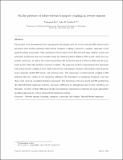On the presence of solute-solvent transport coupling in reverse osmosis
Author(s)
Roy, Yagnaseni; Lienhard, John H
DownloadPreprint solute solvent transport coupling.pdf (1.522Mb)
Open Access Policy
Open Access Policy
Creative Commons Attribution-Noncommercial-Share Alike
Terms of use
Metadata
Show full item recordAbstract
The present work demonstrates that experimental salt passage data for reverse osmosis (RO) shows better agreement with models capturing solute-solvent transport coupling (convective coupling), especially as the applied pressure is increased. This conclusion is drawn based on five RO data sets using cellulose acetate and polyamide membranes that were modeled using the classical solution diffusion (SD) model, which does not include convection, as well as the convection-inclusive SD model introduced by Paul in 2004 and the pore-based model, which also includes convective coupling. The improved model-to-experimental data agreement with solute-solvent coupling is more easily noticed from salt passage variation with pressure than from the most commonly studied RO metric, salt rejection ratio. The importance of solute-solvent coupling in RO indicates that free volume in the membrane influences the description of membrane transport, and that these voids ‘open up’ as applied pressure is increased. The derivation of the pore-based and SD models from the Maxwell-Stefan equations is shown, and major differences in assumptions used in their derivation are discussed. A study of these differences should aid membrane researchers in selecting the most appropriate modeling approach for a given solute-solvent-membrane system.
Date issued
2020-10Department
Massachusetts Institute of Technology. Department of Mechanical EngineeringJournal
Journal of Membrane Science
Publisher
Elsevier BV
Citation
Roy, Yagnaseni and John H.Lienhard V. "On the presence of solute-solvent transport coupling in reverse osmosis." Forthcoming in Journal of Membrane Science 611 (October 2020): 118272 © 2020 Elsevier B.V.
Version: Author's final manuscript
ISSN
0376-7388